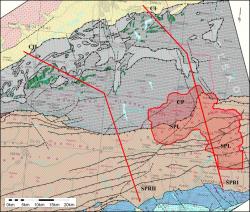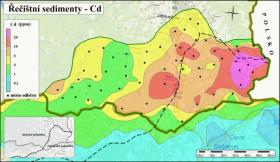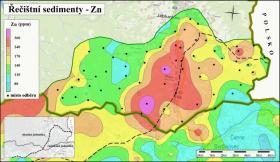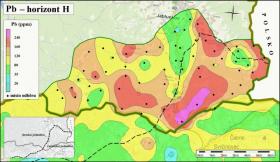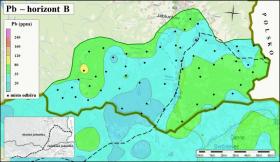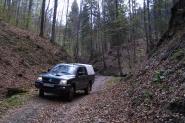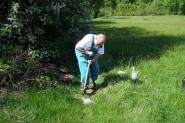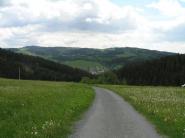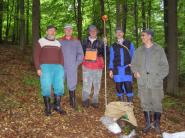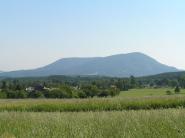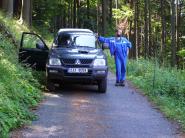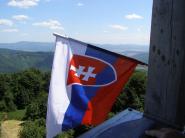 http://www.geomin.cz/
http://www.geomin.cz/
Spolupráce ČR - SR v oblasti environmentální geologie
Projekt „Environmentální výzkum a charakteristika ekologických zátěží ve vnějším flyšovém pásmu Západních Karpat: oblast Jablunkovská brázda (ČR) – Kysucké Beskydy (SR)“ byl řešen ve spolupráci s ŠGÚDŠ Bratislava. Zadavatelem projektů bylo MŽP obou republik, realizace probíhala v letech 2007 – 2010. Cíle úkolu:
- Upřesnit parametry, dešifrovat nositele a posoudit zdroje zjištěných anomálií Hg a dalších polutantů - Pb, Zn, Cd, Cu, Sb, As, Cr, Ni, Co, V aj. ve vymezeném zájmovém území.
- Sestavit deskriptivní modely možného transportu a migrace prvků z anomálních zón do jiných složek životního prostředí a posoudit míru případného rizika na ekosystémy a pro zdraví obyvatelstva.
Zájmové území zahrnuje část flyšového pásma v příhraniční oblasti ČR a SR. Řešení úkolu bylo založeno na aplikaci souboru geochemických (metalometrie, šlichová prospekce, merkurometrie, hydrogeochemie, biogeochemie) a geofyzikálních metod (γ-spektrometrie, kapametrie, magnetometrie) s cílem charakterizovat a vyhodnotit aktuální stav vybraných složek životního prostředí – řečištní sedimenty, půdy, vody, vegetace. Geologické práce byly provedeny na dvou regionálních profilech a na výzkumné ploše:
Profil I: Horní Suchá – Třinec – Oščadnica – Horný Vadičov. Délka 67 km, z toho v ČR 41,5 km, v SR 25,5 km.
Profil II: Suchdol nad Odrou – Čeladná – Bytča. Délka 68,5 km, z toho v ČR 47,5 km , v SR 21 km.
Plošný výzkum: Lomná – Olše – povodí Kysuce. Rozloha 439 km2, z toho v ČR 95 km2, v SR 344 km2.
Na české straně bylo odebráno a analyzováno 60 řečištních sedimentů, 489 vzorků půd, 94 šlichů ze svahovin, 60 vzorků hornin, 28 vzorků vody a 42 vzorků vegetace. Zjištěné hodnoty obsahů sledovaných prvků byly posuzovány podle platných norem a vyhlášek.
Řečištní sedimenty.
Vymezena byla skupina prvků, jejichž zdroj je pravděpodobně
antropogenního původu. Jedná se zejména o Cd, Hg, Pb, Zn a Cu, Sb a Sn,
zčásti As, Mn, Co a Ni. Anomálie jsou prostorově vázány převážně na
české území, u některých prvků dochází k přesahu na Slovensko. Důležitou
rolí má přirozená geomorfologická bariéra, sledující evropské rozvodí
Dunaj – Odra.
Půdy.
V humózním horizontu H se zachycují a projevují depoziční zátěže –
průmyslové spady. Ve vzorcích byly zjišťovány koncentrace těžkých kovů –
polutantů a byly sledovány korelační závislosti mezi koncentracemi kovů
a magnetickou susceptibilitou půd. Vzorky z horizontu B zahrnují část
půdního profilu pod organickým humusovým horizontem a bývají v něm
zachyceny zejména geogenní projevy horninového podloží.
Do skupiny prvků - polutantů patří zejména Pb, Cd, Hg, Sb, Cu, Zn, Bi, Se, S, Ag, W, Mo aj. Skupina prvků převážně geogenního původu zahrnuje Ni, Co, Cr, V, La, Au, Th, Sc, Mg, Al a další. Uvnitř obou skupin existují mezi jednotlivými prvky zpravidla těsné korelační vztahy.
Po komplexním vyhodnocení výsledků analýz půd v horizontu H a B, výsledků chemických a mineralogických analýz koncentrátů těžkých minerálů ze vzorků svahovin a na základě výsledků měření magnetické susceptibility bylo na profilu C I a C II vymezeno 10 anomálních úseků:
- Oblast A: Český Těšín – SZ. Anomálie magnetické susceptibility a anomální asociace rizikových prvků As, Bi, Sb, Ag, Cu, Cd, Hg, Mo, Pb, Sc, Tl, V a Zn antropogenního původu. Vysoké koncentrace Ti, V, Cr, Co, Ni, Sc – geogenní původ, alkalické vulkanity - těšínity v podloží. Kombinace antropogenních i přírodních zdrojů prvků
- Oblast B: Český Těšín – JV. Anomálie antropogenního původu: magnetická susceptibilita a asociace Fe, Cd, Zn, Sb, Bi, As, Pb, Hg, Cu, Mo, Ag, Tl, Fe, Mn, Se, Cr, Ni, Co.
- Oblast C: Třinec. Antropogenní zdroj: magnetická susceptibilita, asociace velmi podobná jako v anomálii B.
- Oblast D: Mosty u Jablunkova. Antropogenní původ. Slabší magnetická susceptibilita. Anomální asociace Pb, Zn, Sb, Bi, Hg, Tl, As, W, Mo, Cu Ag. Anomální S a Se, deficit Fe.
- Oblast E: Drahošanka. Antropogenní původ. Slabě zvýšená susceptibilita. Anomální asociace S, Se, Hg, Tl, Cd, Pb, Sb, Bi, Cu,As, Mo, W, Mn. Deficit Fe a Zn.
- Oblast F: Nový Jičín. Slabá anomálie magnetické susceptibility; anomální asociace rizikových prvků Hg, Mo, W, S, Se, Sb, (Bi, Pb, Ag, Tl, Ba, U, Ba) velmi pravděpodobně antropogenního původu.
- Oblast G: Frenštát pod Radhoštěm. Rozsáhlá anomálie, poněkud variabilní a několikrát přerušovaná nízkými obsahy. Je rozdělena na sz. část – slabá anomálie susceptibility, antropogenní anomálie Zn, Cd, Cu, Mo, Se, (Ag, Tl, Bi, Sb, As, Pb, S). Dále Fe, (Co, Ni, P, Sr, Ca) – možný geogenní původ, v okolním podloží těšínity. Jv. část anomálie - slabá anomálie susceptibility, variabilní antropogenní anomálie Tl, Cu, Pb, Zn, Cd, Ga, As, Sb, Bi, W, Mo, Se a S. Deficit Fe, Co, Ni.
- Oblast H: Smrk. – zalesněný masív Beskyd. Antropogenní anomálie; slabá anomálie magnetické susceptibility, výrazně anomální asociace Pb, Sb, Bi, Tl, Ag, Mo, W, S, Se (Zn, Cd, Hg, As, Ga). Deficit Fe.
- Oblast J: Mezivodí. Relativně slabá anomálie antropogenního původu. Nízká magnetická susceptibilita. Anomální asociace S, Cd, (Bi, Sb, Ag, Tl, Pb, Mo, As, Se).
- Oblast K: Bumbálka. Variabilní antropogenní anomálie. Slabě zvýšená susceptibilita. Anomální obsahy pouze na bodu C II/96 a 95. Asociace Zn, Pb, Cu, Ag, Tl, Ga, As, Sb, Bi, W, Mo, Se, S, (Hg, Cd).
prokázalo účelnost této metody pro environmentální výzkum půd. Potvrdilo se, že magnetická susceptibilita reaguje citlivě na přítomnost antropogenního znečištění ve svrchním horizontu půd, pocházejícího z různých druhů spalovacích procesů, metalurgického průmyslu, báňských aktivit aj. Téměř všechny zvýšené obsahy rizikových prvků našly svůj odraz ve zvýšené magnetické susceptibilitě. Je proto vhodné s tímto parametrem počítat při monitorování rizikových oblastí.
Vzorky vody.
Výsledky ukázaly, že analyzované vzorky vod neobsahují nadlimitní koncentrace rizikových prvků. Naopak v naprosté většině analýz jsou koncentrace nejrizikovějších prvků Cd, Pb a As pod dolní mezí detekce. Přesto by bylo účelné sledovat koncentrace rizikových prvků ve vodách v rámci dlouhodobého monitoringu.
γ-spektrometrie.
Výsledky dokumentují přirozenou radioaktivitu v zájmovém území a aktivitu umělého „černobylského“ radionuklidu 137Cs. Střední hodnoty K, eTh a eU nejsou ničím výjimečné, odpovídají hodnotám běžným ve flyšových souvrstvích, jejichž radioaktivita je obecně nízká. Umělý radionuklid 137Cs (poločas rozpadu 30,1 let) je pozůstatkem černobylské havárie v roce 1986. Cs se koncentruje ve svrchních horizontech půd, zejména v lesních porostech listnatých a jehličnatých, odkud je nasáváno kořenovým systémem, dostává se do listí a jehličí stromů (hub, rostlin atd.) a posléze se vrací do půdy. Na zemědělsky obdělávaných půdách je Cs rozptýleno a jeho koncentrace jsou nízké. Plošná aktivita Cs dosáhla nejvyšších hodnot v horských zalesněných terénech na profilu I (22,4 kBq/m2). Tyto obsahy nepředstavují pro člověka žádné vážné riziko.
Vegetace.
Ve skupině travin ať už lesních nebo travin na loukách a pastvinách, které se používají na senáž nebo jsou přímo vypásány dobytkem, nebylo zjištěno žádné překročení limitů, daných vyhláškou o krmivech. Samostatnou kapitolu představují houby, které jsou všeobecně známým „sběračem“ rizikových kovů, což se potvrdilo i v tomto případě. Anomální koncentrace byly zjištěny hlavně u Pb a Cd a dále Cu, Zn, Hg a zvýšení vykázaly Ag, Se. Nelze doporučit nadměrnou konzumaci hub nasbíraných v lesích, které jsou zamořeny prašným spadem. Koncentrace rizikových kovů v lesních půdách jsou navíc umocněny aktivitou toxického radionuklidu 137Cs.
Závěr.
Přesto, že environmentální riziko ve studovaném území není kritické, nelze jej považovat za zanedbatelné. Nejvyšší riziko pro životní prostředí představují Cd a Pb, v kombinaci s dalšími prvky se může zvyšovat. Posouzení reálné míry tohoto rizika by měla být věnována další pozornost. V každém případě by bylo vhodné koncentrace rizikových prvků v půdách a ve vodách pravidelně monitorovat.
